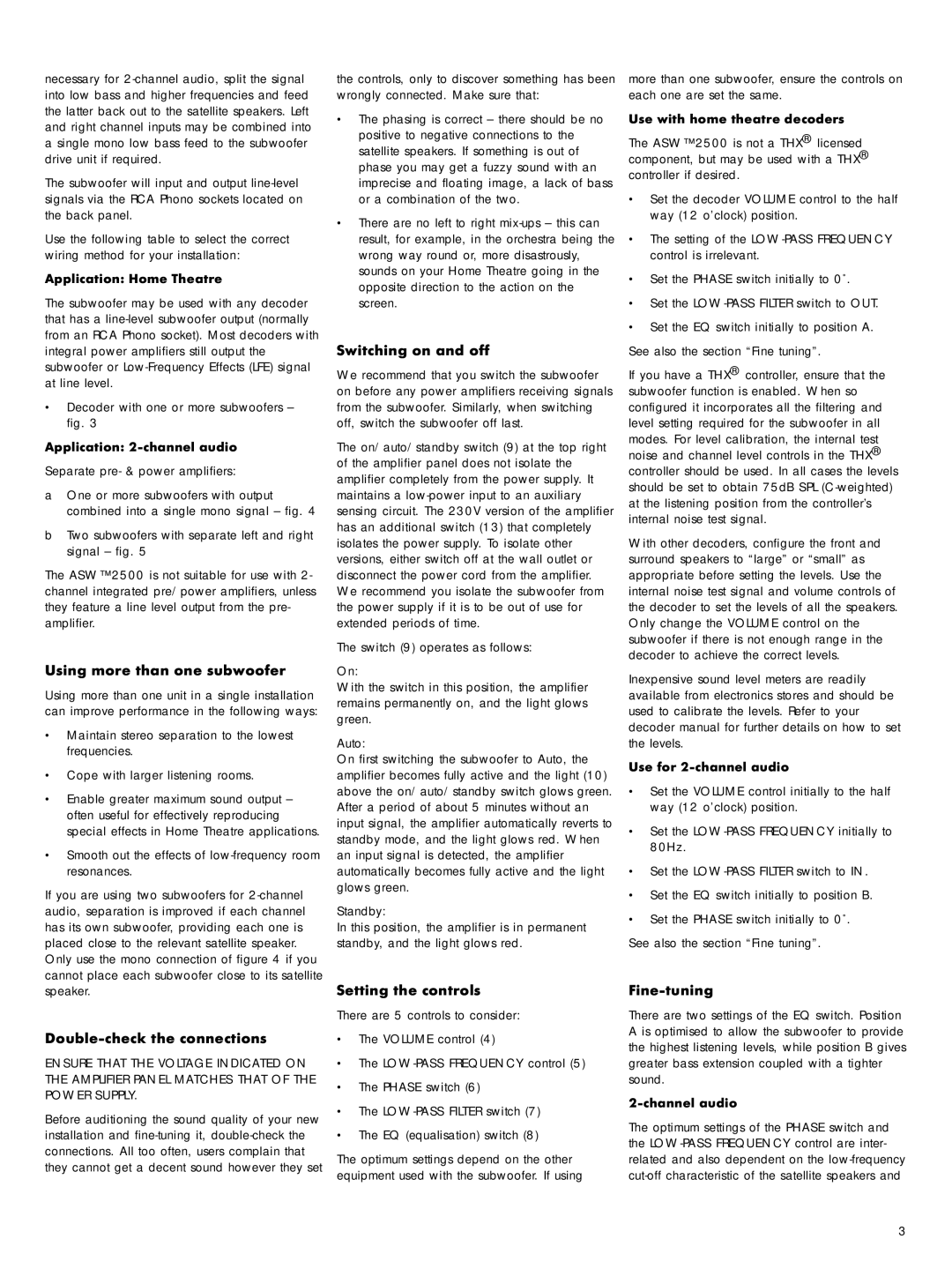necessary for
The subwoofer will input and output
Use the following table to select the correct wiring method for your installation:
Application: Home Theatre
The subwoofer may be used with any decoder that has a
•Decoder with one or more subwoofers – fig. 3
Application: 2-channel audio
Separate pre- & power amplifiers:
aOne or more subwoofers with output combined into a single mono signal – fig. 4
bTwo subwoofers with separate left and right signal – fig. 5
The ASW™2500 is not suitable for use with 2- channel integrated pre/power amplifiers, unless they feature a line level output from the pre- amplifier.
Using more than one subwoofer
Using more than one unit in a single installation can improve performance in the following ways:
•Maintain stereo separation to the lowest frequencies.
•Cope with larger listening rooms.
•Enable greater maximum sound output – often useful for effectively reproducing special effects in Home Theatre applications.
•Smooth out the effects of low-frequency room resonances.
If you are using two subwoofers for
the controls, only to discover something has been wrongly connected. Make sure that:
•The phasing is correct – there should be no positive to negative connections to the satellite speakers. If something is out of phase you may get a fuzzy sound with an imprecise and floating image, a lack of bass or a combination of the two.
•There are no left to right
Switching on and off
We recommend that you switch the subwoofer on before any power amplifiers receiving signals from the subwoofer. Similarly, when switching off, switch the subwoofer off last.
The on/auto/standby switch (9) at the top right of the amplifier panel does not isolate the amplifier completely from the power supply. It maintains a
The switch (9) operates as follows:
On:
With the switch in this position, the amplifier remains permanently on, and the light glows green.
Auto:
On first switching the subwoofer to Auto, the amplifier becomes fully active and the light (10) above the on/auto/standby switch glows green. After a period of about 5 minutes without an input signal, the amplifier automatically reverts to standby mode, and the light glows red. When an input signal is detected, the amplifier automatically becomes fully active and the light glows green.
Standby:
In this position, the amplifier is in permanent standby, and the light glows red.
more than one subwoofer, ensure the controls on each one are set the same.
Use with home theatre decoders
The ASW™2500 is not a THX® licensed component, but may be used with a THX® controller if desired.
•Set the decoder VOLUME control to the half way (12 o’clock) position.
•The setting of the
•Set the PHASE switch initially to 0˚.
•Set the
•Set the EQ switch initially to position A. See also the section “Fine tuning”.
If you have a THX® controller, ensure that the subwoofer function is enabled. When so configured it incorporates all the filtering and level setting required for the subwoofer in all modes. For level calibration, the internal test noise and channel level controls in the THX® controller should be used. In all cases the levels should be set to obtain 75dB SPL
With other decoders, configure the front and surround speakers to “large” or “small” as appropriate before setting the levels. Use the internal noise test signal and volume controls of the decoder to set the levels of all the speakers. Only change the VOLUME control on the subwoofer if there is not enough range in the decoder to achieve the correct levels.
Inexpensive sound level meters are readily available from electronics stores and should be used to calibrate the levels. Refer to your decoder manual for further details on how to set the levels.
Use for 2-channel audio
•Set the VOLUME control initially to the half way (12 o’clock) position.
•Set the
•Set the
•Set the EQ switch initially to position B.
•Set the PHASE switch initially to 0˚.
See also the section “Fine tuning”.
Only use the mono connection of figure 4 if you cannot place each subwoofer close to its satellite speaker.
Double-check the connections
ENSURE THAT THE VOLTAGE INDICATED ON THE AMPLIFIER PANEL MATCHES THAT OF THE POWER SUPPLY.
Before auditioning the sound quality of your new installation and
Setting the controls
There are 5 controls to consider:
•The VOLUME control (4)
•The
•The PHASE switch (6)
•The
•The EQ (equalisation) switch (8)
The optimum settings depend on the other equipment used with the subwoofer. If using
Fine-tuning
There are two settings of the EQ switch. Position A is optimised to allow the subwoofer to provide the highest listening levels, while position B gives greater bass extension coupled with a tighter sound.
2-channel audio
The optimum settings of the PHASE switch and the
3
